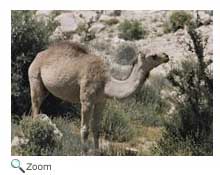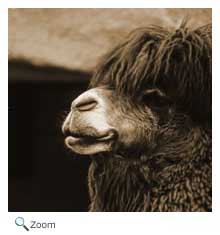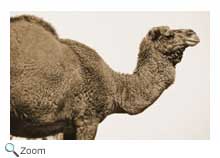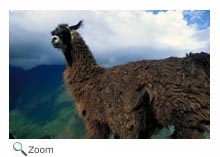What Is The National Animal Of Bolivia Where Else In South America Does It Live
Camelidae - camels, llamas, alpacas, vicugnas
 The six species in this family are found in two groups. Camels are found in Asia and Africa. Llamas, alpacas, and vicugnas are found in S America. The species in this family are large and most of them have been domesticated. They are herbivores and take three-chambered stomachs. Their superlative lip is divide into two and they can move each role separately! They take long necks and a pocket-sized caput and long legs with padded feet with two large toes. They live in small groups made up of females and their young and one adult male person. Although there are no living species of camelidae family in North America today, the fossil record shows that the family started and evolved there. Scientists have found preserved remains in the La Brea Tar Pits virtually Los Angeles. The members of the camelidae family that were in North America probably resembled llamas. Members of this family migrated to S America and Asia over land bridges. By the cease of the last glacial age, they had become extinct in N America.
The six species in this family are found in two groups. Camels are found in Asia and Africa. Llamas, alpacas, and vicugnas are found in S America. The species in this family are large and most of them have been domesticated. They are herbivores and take three-chambered stomachs. Their superlative lip is divide into two and they can move each role separately! They take long necks and a pocket-sized caput and long legs with padded feet with two large toes. They live in small groups made up of females and their young and one adult male person. Although there are no living species of camelidae family in North America today, the fossil record shows that the family started and evolved there. Scientists have found preserved remains in the La Brea Tar Pits virtually Los Angeles. The members of the camelidae family that were in North America probably resembled llamas. Members of this family migrated to S America and Asia over land bridges. By the cease of the last glacial age, they had become extinct in N America.
 The bactrian camel is constitute in the Gobi desert in Mongolia and China. The Gobi desert is a cold desert and the bactrian camel has many adaptations that assist is survive in a cold desert habitat. It has two humps on its dorsum. The hump is not filled with water; it is filled with fat. The camel uses this stored fat when h2o and nutrient are deficient. While the bactrian camel doesn't store water in its humps, it does accept special sack in its stomach that can hold over a gallon of water, and information technology can get a few days without drinking. In the winter, it has a thick, shaggy coat that helps keep it warm. Its bushy eyebrows; long double rows of eyelashes; and nostrils and lips that close tightly help keep sand out of its eyes, nose, and mouth. The bactrian camel stands as tall as 7 anxiety from its shoulder to its anxiety and can weigh up to 2,000 pounds. The bactrian camel is an herbivore and eats grass, leaves, thorns, and bark. It prefers salty plants. It has tough lips that let it eat very hard vegetation. Most bactrian camels are now domesticated and there are simply a few hundred in the wild.
The bactrian camel is constitute in the Gobi desert in Mongolia and China. The Gobi desert is a cold desert and the bactrian camel has many adaptations that assist is survive in a cold desert habitat. It has two humps on its dorsum. The hump is not filled with water; it is filled with fat. The camel uses this stored fat when h2o and nutrient are deficient. While the bactrian camel doesn't store water in its humps, it does accept special sack in its stomach that can hold over a gallon of water, and information technology can get a few days without drinking. In the winter, it has a thick, shaggy coat that helps keep it warm. Its bushy eyebrows; long double rows of eyelashes; and nostrils and lips that close tightly help keep sand out of its eyes, nose, and mouth. The bactrian camel stands as tall as 7 anxiety from its shoulder to its anxiety and can weigh up to 2,000 pounds. The bactrian camel is an herbivore and eats grass, leaves, thorns, and bark. It prefers salty plants. It has tough lips that let it eat very hard vegetation. Most bactrian camels are now domesticated and there are simply a few hundred in the wild.
 The dromedarian camel is found in the deserts in Africa and the Middle E. It has one hump that stores fat, not h2o. It stands 6-vii feet from its shoulder to its anxiety. It has long legs and padded feet with two toes. It has a long, curved neck and a small caput with a long snout with nostrils that tin close. Its upper lip is carve up into two sections, and it can pull its lips in tightly to keep out sand. It is light brown in colour and has a shorter coat than the bactrian camel. It eats a broad variety of plants and tin eat tough and hard plant parts that other animals can't chew or assimilate. It prefers salty plants.
The dromedarian camel is found in the deserts in Africa and the Middle E. It has one hump that stores fat, not h2o. It stands 6-vii feet from its shoulder to its anxiety. It has long legs and padded feet with two toes. It has a long, curved neck and a small caput with a long snout with nostrils that tin close. Its upper lip is carve up into two sections, and it can pull its lips in tightly to keep out sand. It is light brown in colour and has a shorter coat than the bactrian camel. It eats a broad variety of plants and tin eat tough and hard plant parts that other animals can't chew or assimilate. It prefers salty plants.
 The llama, the guanaco, and the alpaca. They are all native to the Andes Mountains in South America and they are all herbivores. The merely wild species is the guanaco. The llama and the alpaca are domesticated. The guanaco is found in the grasslands of the Andes Mountains. It has a modest caput, long legs, and a long neck. It is about three.5 feet alpine from shoulder to feet. It has a shaggy, reddish-brown coat and is white on its undersides. Like the camels, it has a dissever upper lip. Information technology eats grasses and shrubs. The guanaco lives in groups of females and their young and one adult male. Information technology can run at speeds of up to 35 miles per hour. The guanaco is a protected species in Chile and Peru. The llama and the alpaca are descended from the guanaco. The llama was domesticated from the guanaco four,000-5,000 years ago. Llama were used every bit pack animals. The llama is 5.5-six feet tall from head to toe. Information technology has two toes on its padded feet and can easily grip the rocky surfaces in its mountain habitat. The llama has long, shaggy fur. Its fur tin can vary in colour from reddish-chocolate-brown, to white, black, brown, or a combination of colors. Llama fur is used to make apparel. The alpaca was also domesticated from the guanaco. The alpaca is slightly smaller than the llama. It is most v anxiety tall from its caput to its toes. It looks like the llama. Unlike the llama, the alpaca is not used as a pack fauna, but its soft, shaggy fur is used to make clothing.
The llama, the guanaco, and the alpaca. They are all native to the Andes Mountains in South America and they are all herbivores. The merely wild species is the guanaco. The llama and the alpaca are domesticated. The guanaco is found in the grasslands of the Andes Mountains. It has a modest caput, long legs, and a long neck. It is about three.5 feet alpine from shoulder to feet. It has a shaggy, reddish-brown coat and is white on its undersides. Like the camels, it has a dissever upper lip. Information technology eats grasses and shrubs. The guanaco lives in groups of females and their young and one adult male. Information technology can run at speeds of up to 35 miles per hour. The guanaco is a protected species in Chile and Peru. The llama and the alpaca are descended from the guanaco. The llama was domesticated from the guanaco four,000-5,000 years ago. Llama were used every bit pack animals. The llama is 5.5-six feet tall from head to toe. Information technology has two toes on its padded feet and can easily grip the rocky surfaces in its mountain habitat. The llama has long, shaggy fur. Its fur tin can vary in colour from reddish-chocolate-brown, to white, black, brown, or a combination of colors. Llama fur is used to make apparel. The alpaca was also domesticated from the guanaco. The alpaca is slightly smaller than the llama. It is most v anxiety tall from its caput to its toes. It looks like the llama. Unlike the llama, the alpaca is not used as a pack fauna, but its soft, shaggy fur is used to make clothing.
The vicugna is found in the plains and grasslands of the Andes Mountains. It is the smallest member of the camelidae family. It is three anxiety tall from shoulder to feet. It has a slender torso; a long neck; sparse legs; and long, silky fur. It is a reddish-dark-brown on its uppersides and white on its undersides. It has a mane of pilus on its chest. The the vicugna is too known every bit the vicuña.
World Condition Key
![]() Least Business
Least Business ![]() Nearly Threatened
Nearly Threatened ![]() Vulnerable
Vulnerable ![]() Endangered
Endangered ![]() Critically Endangered
Critically Endangered
![]() Extinct in the Wild
Extinct in the Wild ![]() Extinct
Extinct
Status and range is taken from ICUN Redlist. If no condition is listed, there is non enough information to establish status.
US Condition Key
![]() Threatened in U.s.a.
Threatened in U.s.a. ![]() Threatened in NH
Threatened in NH ![]() Endangered in US
Endangered in US ![]() Endangered in NH
Endangered in NH
![]() Breeds in NH
Breeds in NH ![]() Introduced
Introduced
Condition taken from US Fish and Wild animals and NH Fish and Game
New Hampshire Species | North/Central American Species | |
| None | None |
Additional Information
Fundamental: ![]() Contour
Contour ![]() Photos
Photos ![]() Video
Video ![]() Sound
Sound
Camel ![]()
![]()
Did you know that camels were domesticated more than 3,000 years ago?
Source: San Diego Zoo Intended Audience: General Reading Level: Unproblematic/Center School
Alpaca - Lama pacos ![]()
![]()
![]()
Alpacas spit when they are aroused.
Source: Los Angeles Zoo Intended Audience: General Reading Level: Simple/Middle School
Alpaca - Lama pacos ![]()
![]()
![]()
The native range of the alpaca is the central and southern Andes from Republic of peru to Argentina.
Source: Animate being Multifariousness Spider web Intended Audience: Full general Reading Level: Middle/High Schoolhouse
Bactrian Camel - Camelus ferus ![]()
![]()
![]()
![]()
![]()
All domestic camels are descended from the Bactrian camel.
Source: Arkive Intended Audition: Full general Reading Level: Heart School
Bactrian Camel - Camelus ferus ![]()
![]()
![]()
![]()
![]()
![]()
All domestic camels are descended from the Bactrian camel.
Source: BBC Intended Audience: Full general Reading Level: Middle School
Bactrian Camel - Camelus ferus ![]()
![]()
![]()
![]()
Wild Bactrian camels live in northwestern China and Mongolia. Wild Bactrian camels are critically endangered.
Source: National Zoo Intended Audience: General Reading Level: Simple/Middle School
Bactrian Camel - Camelus ferus ![]()
![]()
![]()
![]()
Bactrian camels have pads on their knees that protect their skin when they kneel on the rocky ground.
Source: Minnesota Zoo Intended Audience: General Reading Level: Middle Schoolhouse
Bactrian Camel - Camelus ferus ![]()
![]()
![]()
![]()
Wild Bactrian camels are adapted to handle the extreme temperature changes plant in the wild.
Source: Chicago Zoological Gild Intended Audience: Students Reading Level: Elementary/Middle School
Bactrian Camel - Camelus ferus ![]()
![]()
![]()
![]()
![]()
Long eyelashes and elongated nostrils protect Bactrian camels from blowing grit and sand.
Source: St. Louis Zoo Intended Audience: General Reading Level: Elementary/Centre School
Bactrian Camel - Camelus ferus ![]()
![]()
![]()
The Bactrian camel's two humps incorporate fat, non water.
Source: Enchanted Learning Intended Audience: Students Reading Level: Elementary Schoolhouse
Dromedary - Camelus dromedarius ![]()
![]()
![]()
![]()
![]()
The dromedary'due south hump stores up to 80 pounds of fatty that a camel can break down into water and energy when food and water is not available.
Source: National Geographic Intended Audience: General Reading Level: Uncomplicated/Middle School
Dromedary - Camelus dromedarius ![]()
![]()
![]()
![]()
The Arabian camel eats plants. They have a leathery mouth that lets them consume thorns and dry vegetation. Yum!
Source: The Living Desert Intended Audience: Students Reading Level: Elementary/Middle School
Dromedary- Camelus dromedarius ![]()
![]()
![]()
The dromedary has padded feet that help it walk on the hot sand!
Source: Enchanted Learning Intended Audience: Students Reading Level: Simple School
Guanaco - Lama guanicoe ![]()
![]()
![]()
![]()
This South American animal is related to camels and, like camels, they were were domesticated.
Source: San Diego Zoo Intended Audition: Full general Reading Level: Uncomplicated/Center School
Guanaco - Lama guanicoe ![]()
![]()
![]()
![]()
![]()
The guanaco is the largest wild member of the camelid family in South America, and is believed to exist the antecedent of the domestic llama.
Source: Arkive Intended Audience: General Reading Level: Middle School
Guanaco - Lama guanicoe ![]()
![]()
![]()
![]()
The guanaco is found from southern Republic of peru down the Andean zone of Chile and Argentina to Tierra del Fuego and Navarino Island.
Source: Animal Diversity Web Intended Audience: General Reading Level: Middle/High School
Guanaco - Lama guanicoe ![]()
![]()
![]()
![]()
Guanacos are usually found in minor herds or loosely structured family groups.
Source: Animal Planet Intended Audience: Full general Reading Level: Middle School
Llama - Lama glama ![]()
![]()
![]()
The scientific name for llama is Llama glama! That'southward but fun to say!
Source: Brandywine Zoo Intended Audience: General Reading Level: Middle Schoolhouse
Llama - Lama glama ![]()
![]()
![]()
The llama has a four-chambered tum.
Source: Honolulu Zoo Intended Audience: General Reading Level: Middle Schoolhouse
Llama - Lama glama ![]()
![]()
![]()
The llamas native range is the Andes mountains, but they are no longer not institute in the wild.
Source: Fauna Diversity Web Intended Audience: General Reading Level: Middle/High School
Vicuña - Vicugna vicugna ![]()
![]()
![]()
![]()
![]()
The vicuña is the smallest member of the camelid family.
Source: Arkive Intended Audition: General Reading Level: Middle School
Vicuña - Vicugna vicugna ![]()
![]()
![]()
![]()
The vicuña lies in the Andes of southern Peru, western Bolivia, northwestern Argentina, and northern Chile.
Source: Animal Multifariousness Web Intended Audience: General Reading Level: Middle/High School
Vicuña - Vicugna vicugna ![]()
![]()
![]()
![]()
The vicuña's coat is very thick and traps warm air.
Source: Edinburgh Zoo Intended Audience: Students Reading Level: Unproblematic/Middle Schoolhouse
Source: https://nhpbs.org/wild/camelidae.asp
Posted by: dunnfamenter87.blogspot.com

0 Response to "What Is The National Animal Of Bolivia Where Else In South America Does It Live"
Post a Comment